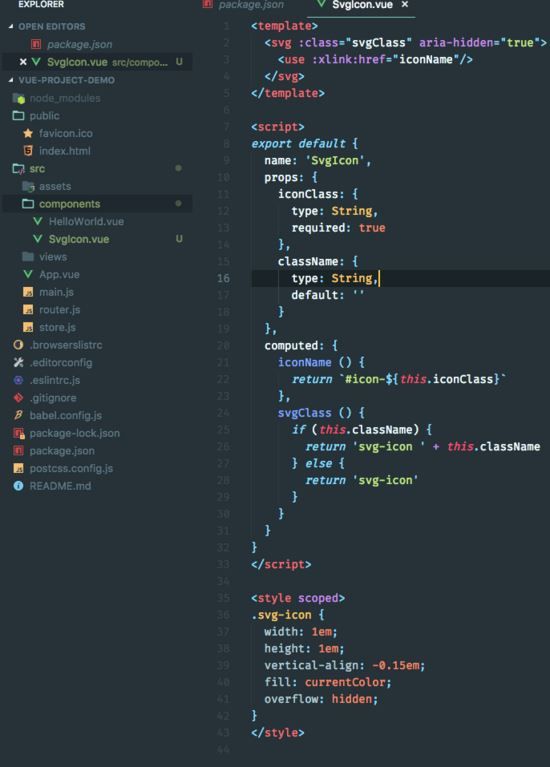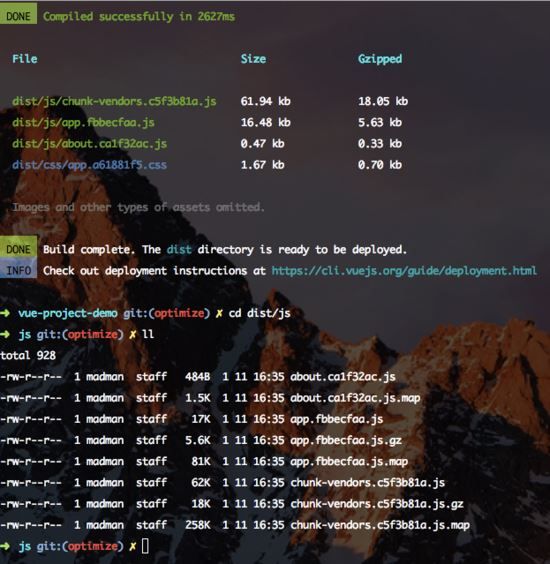前言
github地址: https://github.com/LeeStaySmall/vue-project-demo (完整分支:optimize分支)
demo地址: vue-project-demo.eloco.cn
安装与初始化架构
安装
node >= 8.9 推荐:8.11.0 +
安装: npm install -g @vue/cli
检查: vue --version
如果已安装旧版本,需要先 npm uninstall vue-cli -g 卸载掉旧版本。
初始化架构
创建: vue create project-name
注:项目名称不能驼峰命名。
选择一个预设(这里我选择更多功能):
选择需要安装的(Babel、Router、Vuex、Pre-processors、Linter / Formatter):
是否使用history路由模式(Yes):
![]()
选择css 预处理器(Sass/SCSS):
选择eslint 配置(ESLint + Standard config):
选择什么时候执行eslint校验(Lint on save):
选择以什么样的形式配置以上所选的功能(In dedicated config files):
是否将之前的设置保存为一个预设模板(y):
![]()
如果选择 y 会让输入名称,以便下次直接使用,否则直接开始初始化项目。
最后,看一下生成的基本架构目录:
在项目中优雅的使用svg 首先在 /src/components 创建 SvgIcon.vue :
在 src/ 下创建 icons 文件夹,以及在其下创建 svg 文件夹用于存放svg文件,创建 index.js 作为入口文件:
编写index.js 的脚本:
import Vue from 'vue'
import SvgIcon from '@/components/SvgIcon.vue' // svg组件
// 全局注册
Vue.component('svg-icon', SvgIcon)
const requireAll = requireContext => requireContext.keys().map(requireContext)
const req = require.context('./svg', false, /\.svg$/)
requireAll(req)
使用 svg-sprite-loader 对项目中使用的 svg 进行处理:
npm install svg-sprite-loader --save-dev ;
修改默认的 webpack 配置, 在项目根目录创建 vue.config.js ,代码如下;
const path = require('path')
function resolve(dir) {
return path.join(__dirname, './', dir)
}
module.exports = {
chainWebpack: config => {
// svg loader
const svgRule = config.module.rule('svg') // 找到svg-loader
svgRule.uses.clear() // 清除已有的loader, 如果不这样做会添加在此loader之后
svgRule.exclude.add(/node_modules/) // 正则匹配排除node_modules目录
svgRule // 添加svg新的loader处理
.test(/\.svg$/)
.use('svg-sprite-loader')
.loader('svg-sprite-loader')
.options({
symbolId: 'icon-[name]'
})
// 修改images loader 添加svg处理
const imagesRule = config.module.rule('images')
imagesRule.exclude.add(resolve('src/icons'))
config.module
.rule('images')
.test(/\.(png|jpe?g|gif|svg)(\?.*)?$/)
}
}
最后,在 main.js 中引入 import '@/icons' 即可;
// 使用示例
PS:至于svg ,个人比较建议使用阿里开源的图标库iconFont
axios封装api、模块化vuex
axios篇
项目中安装 axios : npm install axios ;
在 src 目录下创建 utils/ , 并创建 request.js 用来封装 axios ,上代码:
import axios from 'axios'
// 创建axios 实例
const service = axios.create({
baseURL: process.env.BASE_API, // api的base_url
timeout: 10000 // 请求超时时间
})
// request 拦截器
service.interceptors.request.use(
config => {
// 这里可以自定义一些config 配置
return config
},
error => {
// 这里处理一些请求出错的情况
console.log(error)
Promise.reject(error)
}
)
// response 拦截器
service.interceptors.response.use(
response => {
const res = response.data
// 这里处理一些response 正常放回时的逻辑
return res
},
error => {
// 这里处理一些response 出错时的逻辑
return Promise.reject(error)
}
)
export default service
既然要使用 axios ,必不可少的需要配置环境变量以及需要请求的地址,这里可以简单的修改 poackage.json :
"scripts": {
"dev": "vue-cli-service serve --project-mode dev",
"test": "vue-cli-service serve --project-mode test",
"pro": "vue-cli-service serve --project-mode pro",
"pre": "vue-cli-service serve --project-mode pre",
"build:dev": "vue-cli-service build --project-mode dev",
"build:test": "vue-cli-service build --project-mode test",
"build:pro": "vue-cli-service build --project-mode pro",
"build:pre": "vue-cli-service build --project-mode pre",
"build": "vue-cli-service build",
"lint": "vue-cli-service lint"
},
同时修改vue.config.js:
const path = require('path')
function resolve(dir) {
return path.join(__dirname, './', dir)
}
module.exports = {
chainWebpack: config => {
// 这里是对环境的配置,不同环境对应不同的BASE_API,以便axios的请求地址不同
config.plugin('define').tap(args => {
const argv = process.argv
const mode = argv[argv.indexOf('--project-mode') + 1]
args[0]['process.env'].MODE = `"${mode}"`
args[0]['process.env'].BASE_API = '"http://47.94.138.75:8000"'
return args
})
// svg loader
const svgRule = config.module.rule('svg') // 找到svg-loader
svgRule.uses.clear() // 清除已有的loader, 如果不这样做会添加在此loader之后
svgRule.exclude.add(/node_modules/) // 正则匹配排除node_modules目录
svgRule // 添加svg新的loader处理
.test(/\.svg$/)
.use('svg-sprite-loader')
.loader('svg-sprite-loader')
.options({
symbolId: 'icon-[name]'
})
// 修改images loader 添加svg处理
const imagesRule = config.module.rule('images')
imagesRule.exclude.add(resolve('src/icons'))
config.module
.rule('images')
.test(/\.(png|jpe?g|gif|svg)(\?.*)?$/)
}
}
如何使用? 我比较建议在 src/ 下创建 api 目录,用来统一管理所有的请求,比如下面这样: ‘'
这样的好处是方便管理、后期维护,还可以和后端的微服务对应,建立多文件存放不同模块的 api 。剩下的就是你使用到哪个api时,自己引入便可。
拓展:服务端的cors设置
牵涉到跨域,这里采用 cors ,很多朋友在面试中经常会被问到cors的实现原理,这个网上有很多理论大多是这样讲的:
其实,这样理解很抽象,服务器端到底是怎么做验证的?
这里大家可以通俗的理解为后端在接收前端的 request 请求的时候,会有一个 request 拦截器,像 axios response 拦截器一样。下面以 php lumen 框架为例,来深入理解一下这个流程:
$request->all()]));
$allowOrigin = [
'http://47.94.138.75',
'http://localhost',
];
$Origin = $request->header("Origin");
$this->headers = [
'Access-Control-Allow-Headers' => 'Origin,x-token,Content-Type',
'Access-Control-Allow-Methods' => 'GET, POST, PUT, DELETE, OPTIONS',
'Access-Control-Allow-Credentials' => 'true',//允许客户端发送cookie
'Access-Control-Allow-Origin' => $Origin,
//'Access-Control-Max-Age' => 120, //该字段可选,间隔2分钟验证一次是否允许跨域。
];
//获取请求方式
if ($request->isMethod('options')) {
if (in_array($Origin, $allowOrigin)) {
return $this->setCorsHeaders(new Response(json_encode(['code' => Code::SUCCESS, "data" => 'success', "msg" => ""]), Code::SUCCESS));
} else {
return new Response(json_encode('fail', 405));
}
}
$response = $next($request);
//返回参数
Log::info('http response:'.json_encode($response));
return $this->setCorsHeaders($response);
}
/**
* @param $response
* @return mixed
*/
public function setCorsHeaders($response)
{
foreach ($this->headers as $key => $val) {
$response->header($key, $val);
}
return $response;
}
}
vuex 篇
如果创建项目的时候,选择了 vuex ,那么默认会在 src 目录下有一个 store.js 作为仓库文件。但在更多实际场景中,如果引入 vuex ,那么肯定避免不了分模块,先来看一下默认文件代码:
import Vue from 'vue'
import Vuex from 'vuex'
Vue.use(Vuex)
export default new Vuex.Store({
state: {
},
mutations: {
},
actions: {
}
})
那么现在改造一下,比如先划分出 app 、 user 两个模块,可以这样:
import Vue from 'vue'
import Vuex from 'vuex'
import app from './store/modules/app'
import user from './store/modules/user'
import getters from './store/getters'
Vue.use(Vuex)
const store = new Vuex.Store({
modules: {
app,
user
},
getters
})
export default store
在 src/ 下创建 store/ 目录:
app module 可以用来存储应用的状态,比如接下来要讲到的全局 loading ,或者控制第三方组件的全局大小,比如 element ui 中的全局组件 size ;
user module 可以用来存储当前用户的信息;
当然,store 配合本地存储比较完美,这里采用 js-cookie 。
全局loading、合理利用vue router守卫
全局loading
上面说完了 axios、vuex ,现在结合之前说一下设置全局 loading 效果。
平常写代码每个请求之前一般都需要设置 loading ,成功之后结束 loading 效果,这就迫使我们不得不写大量重复代码,如果不想这样做,可以结合 axios 和 vuex 统一做了。
首先,在说 vuex 的时候,我在 src/ 下创建了一个 store ,现在就在 store/modules/app.js 写这个 Loading 效果的代码;
const app = {
state: {
requestLoading: 0
},
mutations: {
SET_LOADING: (state, status) => {
// error 的时候直接重置
if (status === 0) {
state.requestLoading = 0
return
}
state.requestLoading = status ? ++state.requestLoading : --state.requestLoading
}
},
actions: {
SetLoading ({ commit }, status) {
commit('SET_LOADING', status)
}
}
}
export default app
再来修改一下 utils/request.js
import axios from 'axios'
import store from '@/store'
// 创建axios 实例
const service = axios.create({
baseURL: process.env.BASE_API, // api的base_url
timeout: 10000 // 请求超时时间
})
// request 拦截器
service.interceptors.request.use(
config => {
// 这里可以自定义一些config 配置
// loading + 1
store.dispatch('SetLoading', true)
return config
},
error => {
// 这里处理一些请求出错的情况
// loading 清 0
setTimeout(function () {
store.dispatch('SetLoading', 0)
}, 300)
console.log(error)
Promise.reject(error)
}
)
// response 拦截器
service.interceptors.response.use(
response => {
const res = response.data
// 这里处理一些response 正常放回时的逻辑
// loading - 1
store.dispatch('SetLoading', false)
return res
},
error => {
// 这里处理一些response 出错时的逻辑
// loading - 1
store.dispatch('SetLoading', false)
return Promise.reject(error)
}
)
export default service
其次,在 src/components/ 下创建 RequestLoading.vue 组件:
最后,在 app.vue 中引入即可。
附: 为了方便演示,项目里出了初始化包括 axios 、 vuex 、 vue-router , 项目使用了 js-cookie 、 element-ui 等,此步骤之后,会改造一下 app.vue ;
vue router守卫
vue-router 提供了非常方便的钩子,可以让我们在做路由跳转的时候做一些操作,比如常见的权限验证。
首先,需要在 src/utils/ 下创建 auth.js ,用于存储token;
import Cookies from 'js-cookie'
const TokenKey = 'project-token'
export function getToken () {
return Cookies.get(TokenKey)
}
export function setToken (token) {
return Cookies.set(TokenKey, token)
}
export function removeToken () {
return Cookies.remove(TokenKey)
}
在 src/utils/ 下创建 permission.js :
import router from '@/router'
import store from '@/store'
import {
getToken
} from './auth'
import NProgress from 'nprogress' // 进度条
import 'nprogress/nprogress.css' // 进度条样式
import {
Message
} from 'element-ui'
const whiteList = ['/login'] // 不重定向白名单
router.beforeEach((to, from, next) => {
NProgress.start()
if (getToken()) {
if (to.path === '/login') {
next({
path: '/'
})
NProgress.done()
} else { // 实时拉取用户的信息
store.dispatch('GetUserInfo').then(res => {
next()
}).catch(err => {
store.dispatch('FedLogOut').then(() => {
Message.error('拉取用户信息失败,请重新登录!' + err)
next({
path: '/'
})
})
})
}
} else {
if (whiteList.includes(to.path)) {
next()
} else {
next('/login')
NProgress.done()
}
}
})
router.afterEach(() => {
NProgress.done() // 结束Progress
})
Nginx try_files 以及 404
nginx 配置如下:
location / {
root /www/vue-project-demo/;
try_files $uri $uri/ /index.html index.htm;
}
try_files : 可以理解为nginx 不处理你的这些url地址请求; 那么服务器如果不处理了,前端要自己做一些404 操作,比如下面这样:
// router.js
import Vue from 'vue'
import Router from 'vue-router'
import Home from './views/Home.vue'
Vue.use(Router)
export default new Router({
mode: 'history',
base: process.env.BASE_URL,
routes: [
{ path: '/404', component: () => import('@/views/404') },
{
path: '/',
name: 'home',
component: Home
},
{
path: '/about',
name: 'about',
// route level code-splitting
// this generates a separate chunk (about.[hash].js) for this route
// which is lazy-loaded when the route is visited.
component: () => import(/* webpackChunkName: "about" */ './views/About.vue')
},
{ path: '*', redirect: '/404' }
]
})
然后写一个404 的view 就ok 。
常用的utils
到现在为止, utils/ 目录下应该有 auth.js 、permission.js、request.js ;
- 那么对与一些常用的方法,你可以放到
utils/common.js里,统一install到vue实例上,并通过Vue.use()使用; - 对于一些全局的过滤器,你仍可以放到
utils/filters.js里,使用Vue.fileter()注册到全局; - 对于一些全局方法,又不是很长用到的,可以放到
utils/index.js,哪里使用哪里import
mixin减少项目冗余代码
直接看代码吧,要写奔溃了....
使用cdn减少文件打包的体积
到此时,看我项目里都用了什么:
主要就是这些,那么执行一下打包命令呢?
可能这时候你还觉得没什么, 单文件最多的还没超过 800kb 呢...
我把项目通过 jenkins 部署到服务器上,看一下访问:
可以看到, chunk-vendors 加载了将近12秒,这还是只有框架没有内容的前提下,当然你可能说你项目中用不到 vuex 、用不到 js-cookie ,但是随着项目的迭代维护,最后肯定不比现在小。
那么,有些文件在生产环境是不是可以尝试使用 cdn 呢?
为了方便对比,这里保持原代码不动( master 分支),再切出来一个分支改动优化( optimize 分支), 上代码:
// vue.config.js 修改
const path = require('path')
function resolve(dir) {
return path.join(__dirname, './', dir)
}
// cdn预加载使用
const externals = {
'vue': 'Vue',
'vue-router': 'VueRouter',
'vuex': 'Vuex',
'axios': 'axios',
'element-ui': 'ELEMENT',
'js-cookie': 'Cookies',
'nprogress': 'NProgress'
}
const cdn = {
// 开发环境
dev: {
css: [
'https://unpkg.com/element-ui/lib/theme-chalk/index.css',
'https://cdn.bootcss.com/nprogress/0.2.0/nprogress.min.css'
],
js: []
},
// 生产环境
build: {
css: [
'https://unpkg.com/element-ui/lib/theme-chalk/index.css',
'https://cdn.bootcss.com/nprogress/0.2.0/nprogress.min.css'
],
js: [
'https://cdn.jsdelivr.net/npm/[email protected]/dist/vue.min.js',
'https://cdn.jsdelivr.net/npm/[email protected]/dist/vue-router.min.js',
'https://cdn.jsdelivr.net/npm/[email protected]/dist/vuex.min.js',
'https://cdn.jsdelivr.net/npm/[email protected]/dist/axios.min.js',
'https://unpkg.com/element-ui/lib/index.js',
'https://cdn.bootcss.com/js-cookie/2.2.0/js.cookie.min.js',
'https://cdn.bootcss.com/nprogress/0.2.0/nprogress.min.js'
]
}
}
module.exports = {
chainWebpack: config => {
// 这里是对环境的配置,不同环境对应不同的BASE_API,以便axios的请求地址不同
config.plugin('define').tap(args => {
const argv = process.argv
const mode = argv[argv.indexOf('--project-mode') + 1]
args[0]['process.env'].MODE = `"${mode}"`
args[0]['process.env'].BASE_API = '"http://47.94.138.75:8000"'
return args
})
/**
* 添加CDN参数到htmlWebpackPlugin配置中, 详见public/index.html 修改
*/
config.plugin('html').tap(args => {
if (process.env.NODE_ENV === 'production') {
args[0].cdn = cdn.build
}
if (process.env.NODE_ENV === 'development') {
args[0].cdn = cdn.dev
}
return args
})
// svg loader
const svgRule = config.module.rule('svg') // 找到svg-loader
svgRule.uses.clear() // 清除已有的loader, 如果不这样做会添加在此loader之后
svgRule.exclude.add(/node_modules/) // 正则匹配排除node_modules目录
svgRule // 添加svg新的loader处理
.test(/\.svg$/)
.use('svg-sprite-loader')
.loader('svg-sprite-loader')
.options({
symbolId: 'icon-[name]'
})
// 修改images loader 添加svg处理
const imagesRule = config.module.rule('images')
imagesRule.exclude.add(resolve('src/icons'))
config.module
.rule('images')
.test(/\.(png|jpe?g|gif|svg)(\?.*)?$/)
},
// 修改webpack config, 使其不打包externals下的资源
configureWebpack: config => {
const myConfig = {}
if (process.env.NODE_ENV === 'production') {
// 1. 生产环境npm包转CDN
myConfig.externals = externals
}
if (process.env.NODE_ENV === 'development') {
/**
* 关闭host check,方便使用ngrok之类的内网转发工具
*/
myConfig.devServer = {
disableHostCheck: true
}
}
// open: true,
// hot: true
// // https: true,
// // proxy: {
// // '/proxy': {
// // target: 'http://47.94.138.75',
// // // changeOrigin: true,
// // pathRewrite: {
// // '^/proxy': ''
// // }
// // }
// // },
// }
return myConfig
}
}
最后去除 main.js 中引入的 import 'element-ui/lib/theme-chalk/index.css'
OK ,现在执行一下 build :
可以看到,相对于 793.20KB , 61.94k 小了将近 13 倍!!!
把这个分支部署到服务器,话不多说,对比一下就好:
使用Gzip 加速
引入 compression-webpack-plugin : npm i -D compression-webpack-plugin https://www.webpackjs.com/plugins/compression-webpack-plugin/
修改 vue.config.js ,老规矩,上最全的代码:
const path = require('path')
const CompressionWebpackPlugin = require('compression-webpack-plugin')
function resolve(dir) {
return path.join(__dirname, './', dir)
}
// cdn预加载使用
const externals = {
'vue': 'Vue',
'vue-router': 'VueRouter',
'vuex': 'Vuex',
'axios': 'axios',
'element-ui': 'ELEMENT',
'js-cookie': 'Cookies',
'nprogress': 'NProgress'
}
const cdn = {
// 开发环境
dev: {
css: [
'https://unpkg.com/element-ui/lib/theme-chalk/index.css',
'https://cdn.bootcss.com/nprogress/0.2.0/nprogress.min.css'
],
js: []
},
// 生产环境
build: {
css: [
'https://unpkg.com/element-ui/lib/theme-chalk/index.css',
'https://cdn.bootcss.com/nprogress/0.2.0/nprogress.min.css'
],
js: [
'https://cdn.bootcss.com/vue/2.5.21/vue.min.js',
'https://cdn.bootcss.com/vue-router/3.0.2/vue-router.min.js',
'https://cdn.bootcss.com/vuex/3.0.1/vuex.min.js',
'https://cdn.bootcss.com/axios/0.18.0/axios.min.js',
'https://unpkg.com/element-ui/lib/index.js',
'https://cdn.bootcss.com/js-cookie/2.2.0/js.cookie.min.js',
'https://cdn.bootcss.com/nprogress/0.2.0/nprogress.min.js'
]
}
}
// 是否使用gzip
const productionGzip = true
// 需要gzip压缩的文件后缀
const productionGzipExtensions = ['js', 'css']
module.exports = {
chainWebpack: config => {
// 这里是对环境的配置,不同环境对应不同的BASE_API,以便axios的请求地址不同
config.plugin('define').tap(args => {
const argv = process.argv
const mode = argv[argv.indexOf('--project-mode') + 1]
args[0]['process.env'].MODE = `"${mode}"`
args[0]['process.env'].BASE_API = '"http://47.94.138.75:8000"'
return args
})
/**
* 添加CDN参数到htmlWebpackPlugin配置中, 详见public/index.html 修改
*/
config.plugin('html').tap(args => {
if (process.env.NODE_ENV === 'production') {
args[0].cdn = cdn.build
}
if (process.env.NODE_ENV === 'development') {
args[0].cdn = cdn.dev
}
return args
})
// svg loader
const svgRule = config.module.rule('svg') // 找到svg-loader
svgRule.uses.clear() // 清除已有的loader, 如果不这样做会添加在此loader之后
svgRule.exclude.add(/node_modules/) // 正则匹配排除node_modules目录
svgRule // 添加svg新的loader处理
.test(/\.svg$/)
.use('svg-sprite-loader')
.loader('svg-sprite-loader')
.options({
symbolId: 'icon-[name]'
})
// 修改images loader 添加svg处理
const imagesRule = config.module.rule('images')
imagesRule.exclude.add(resolve('src/icons'))
config.module
.rule('images')
.test(/\.(png|jpe?g|gif|svg)(\?.*)?$/)
},
// 修改webpack config, 使其不打包externals下的资源
configureWebpack: config => {
const myConfig = {}
if (process.env.NODE_ENV === 'production') {
// 1. 生产环境npm包转CDN
myConfig.externals = externals
myConfig.plugins = []
// 2. 构建时开启gzip,降低服务器压缩对CPU资源的占用,服务器也要相应开启gzip
productionGzip && myConfig.plugins.push(
new CompressionWebpackPlugin({
test: new RegExp('\\.(' + productionGzipExtensions.join('|') + ')$'),
threshold: 8192,
minRatio: 0.8
})
)
}
if (process.env.NODE_ENV === 'development') {
/**
* 关闭host check,方便使用ngrok之类的内网转发工具
*/
myConfig.devServer = {
disableHostCheck: true
}
}
// open: true,
// hot: true
// // https: true,
// // proxy: {
// // '/proxy': {
// // target: 'http://47.94.138.75',
// // // changeOrigin: true,
// // pathRewrite: {
// // '^/proxy': ''
// // }
// // }
// // },
// }
return myConfig
}
}
再次运行 build ,我们会发现 dist/ 下所有的 .js 和 .css 都会多出一个 .js.gz、.css.gz 的文件,这就是我们需要的压缩文件,可以看到最大的只有 18.05KB ,想想是不是比较激动...
当然,这玩意还需要服务端支持,也就是配置 nginx :
gzip on; gzip_static on; gzip_min_length 1024; gzip_buffers 4 16k; gzip_comp_level 2; gzip_types text/plain application/javascript application/x-javascript text/css application/xml text/javascript application/x-httpd-php application/vnd.ms-fontobject font/ttf font/opentype font/x-woff image/svg+xml; gzip_vary off; gzip_disable "MSIE [1-6]\.";
配置完重启 nginx :
配置成功的话,可以看到加载的是比较小的 Gzip :
![]()
在 response headers 里会有一个 Content-Encoding:gzip
以上就是本文的全部内容,希望对大家的学习有所帮助,也希望大家多多支持脚本之家。



















